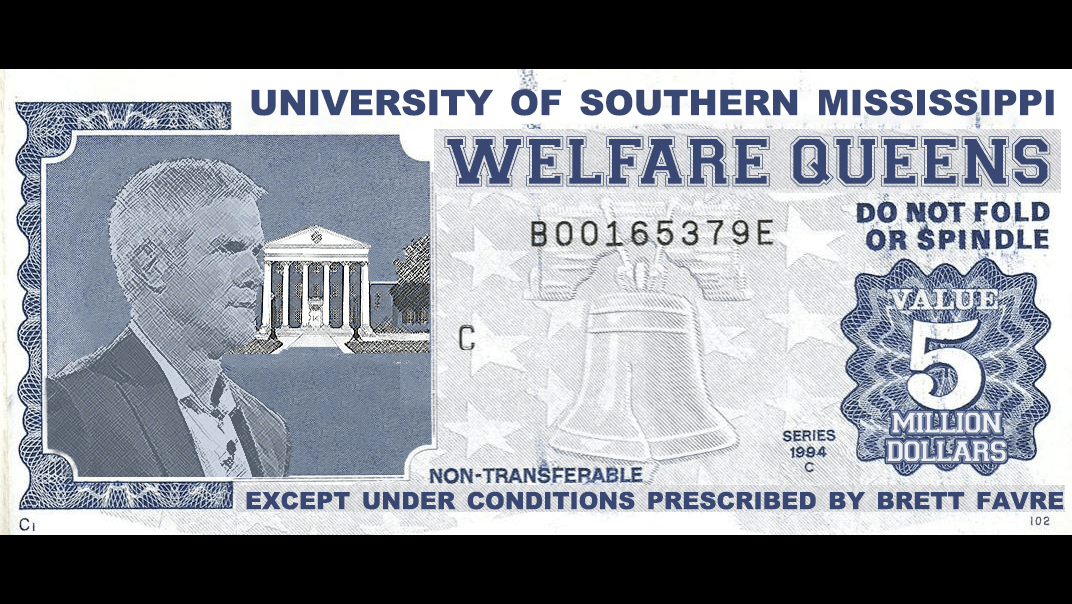The greatest welfare kings and queens of white history
OPINION: Brett Favre’s alleged welfare fraud places him on a long list of white scammers who stole from Black people to make themselves rich.

Editor’s note: The following article is an op-ed, and the views expressed are the author’s own. Read more opinions on theGrio.
After retiring from his 20-year professional football career, the man who still ranks 22nd on the list of the highest-paid players in NFL history surveyed his career prospects and decided to follow in the footsteps of his ancestors. Favre passed on the family tradition of welfare fraud by allegedly using money designated for the poorest residents in America’s poorest state to build a volleyball facility for his daughter’s University of Southern Mississippi volleyball team.
According to reporting by Mississippi Today, Gov. Phil Bryant’s welfare director “instantaneously committed $4 million in federal welfare funds to the Favre volleyball project” at the behest of Favre. Court filings allege that a nonprofit organization tasked with helping raise Mississippians out of poverty paid $5 million in welfare funds to the volleyball project and gave another $1.1 million directly to Favre. Still needing money, Favre suggested using prison labor, apparently interested in the loophole buried in the 13th Amendment that bans slavery “except as a punishment for crime.”
While these revelations left many people aghast, Favre is reportedly a direct descendant of Simon Favre, a French interpreter who died owning 57 Black people, and Simon Favre’s Native American mistress, a member of the Choctaw tribe that exiled their Black freedmen and banned them from collecting government funds. He is just the latest in a long line of white people who built generational prosperity by burgling the labor, intellectual property and wealth of Black people.
But who are the greatest welfare cheats in history?
Well, for the sake of this argument, we used the Oxford English Definition of welfare—a “Statutory procedure or social effort designed to promote the basic physical and material well-being of people in need.” Although we initially wanted to list the top 10, we found it impossible to whittle our list down to 10. So here are the greatest 11 white kings and queens of welfare.
11. 400,000 acres and no a mule
Even before William Tecumseh Sherman took the advice of 20 Black ministers and issued Field Order No. 15, Black people were creating government programs to get their 40 acres. There was the Port Royal Experiment, the all-Black town of Mitchelville and the Boston Concern, projects that redistributed the captured and abandoned land of confederate traitors. But none of these rivaled the South Carolina Land Commission.
For most of its existence, South Carolina was a majority Black state. After the 13th Amendment made them full citizens in 1869, the state’s Black electorate took over the legislature, created America’s first free statewide public education system and formed the South Carolina Land Commission. The SCLC used state funds to purchase land and resell it to freedmen using low-interest loans. Not only did this create a base of Black economic power, the state actually made a profit! There was just one problem:
White people were in control.
The first two corrupt commissioners embezzled funds and turned a blind eye to violent terrorist organizations that forced African Americans to make straw land purchases at discount prices. By the time Black educator and minister Francis Cardozo was put in charge, the commission was almost bankrupt. Cardozo had almost righted the land commission’s ship when the Compromise of 1877 ushered in the Jim Crow era. The white minority disenfranchised Blacks, seized control of the state legislature and sold most of the land to whites. Even though the freedman (including my ancestors) were able to purchase about 44,000 acres, confederate slaveholders ended up with more land than they did before the Civil War. Still unsatisfied, the white welfare cheats convinced newly-freed African Americans to work the land in a system that became known as “sharecropping.”
South Carolina’s post-Reconstruction welfare system for whites is the origin of the infamous lament: “We were eight years in power.”
10. Young, gifted and white
While journalists and politicians often point out the inequities in the American education system, we rarely acknowledge how white achievement is subsidized by Black taxpayers. Perhaps the best example of this is the infrastructure dedicated to high-achieving students in public schools all across America.
Programs for gifted and talented students are almost exclusively populated by white, Asian and high-income children. Not only do white children benefit from these individual gifted and talented curriculums, but diverse cities like New York essentially created a network of segregated academies within the public school system, funded by the Black and brown citizens whose children are excluded. The result is a more unequal education system that catapults white kids toward a life of success while Black children fund other children’s generational wealth.
And if you think it’s not welfare, consider how much money wealthy white families save on private education and tutors by sending their kids to these public schools. Remember that the tests that measure “gifts” and “talents” are racially biased. Remember that the entrance exams are essentially a measure of socioeconomic status and parents’ ability to pay for expensive exam preparation. Remember that Black families pay more in property tax, the “single largest source of local revenue for schools in the United States.” Remember that majority-Black school districts receive $2,226 less per student than majority-white districts. Remember that majority-Black schools are less likely to have AP or advanced curriculums. Remember that there is no universally accepted standard for what defines “gifted; it’s a “purely local responsibility and is dependent on local leadership.”
In this “social effort designed to promote the basic physical and material well-being of people in need,” the “people in need” are almost exclusively white.
9 . The road to white Wall Streets
Even when Tulsa’s Greenwood neighborhood was thriving, if you mentioned Black Wall Street, most people would assume you meant Durham, N.C.’s Hayti District, probably the most prosperous Black business district in America. Hayti’s Black-owned businesses were so successful that white businesses started popping up in the neighborhood. They wanted the Black dollars money, but they also wanted to enforce segregation laws and keep their employees all-white. On June 24, 1957, new Hayti resident Rev. Douglas Moore and six young activists walked to Royal Ice Cream Parlor in downtown Hayti, sat in the white section and refused to move. Owner Louis Colletta called the police, who arrested the students. Moore’s “radical” protest made Durham’s all-white city council stop working with Black leaders in Hayti on a planned urban renewal highway project that eventually displaced 4,000 families and 500 businesses. To be fair, while the highway served “white business interests” and dismantled Hayti, it linked the white downtown districts to the two largest predominately white universities, creating the affluent Research Triangle, consistently ranked as one of the best places to live in America…
For white people.
Since President Dwight Eisenhower created the U.S. interstate system in 1956, the resulting “highway boom” has destroyed more Black communities than hip-hop lyrics, Black-on-Black crime and sagging pants combined. We rarely mention how these publicly funded highways use public resources to create white wealth at the expense of Black neighborhoods in Winston-Salem, N.C., New Orleans, Los Angeles’ Sugar Hill and…well, Black neighborhoods in Little Rock, Ark., didn’t really suffer because the city had “no widespread…Negro sections of residence”…until it was segregated by three interstates.
When a curve was added to Interstate 40 in Nashville to avoid a white neighborhood, the residents of the historic area known as “Black Nashville” lost 600 homes, 30 apartment buildings, 100 businesses and easy access to three HBCUs. But the highway also funneled traffic to newly developed business districts and increased the value of homes in Nashville’s white suburbs. White homeowners and white-owned businesses actually profited from destroying Black history.
On the bright side, the Royal Ice Cream protest—the civil rights movement’s first “sit-in”–inspired one of Moore’s college classmates (some guy named Martin Luther King Jr.) to use the technique in his quest to make America one of the best places to live. Or maybe he dreamed of a place described by W.E.B. Du Bois:
“Today, there is a singular group in Durham where a black man may get up in the morning from a mattress made by a black man, in a house which a black man built out of lumber which black men cut and planed; he may put on a suit which he bought at a colored haberdashery and socks knit at a colored mill; he may cook victuals from a colored grocery on a stove which black men fashioned; he may earn his living working for colored men, be sick in a colored hospital and buried from a colored church; and the Negro insurance society will pay his widow enough to keep his children in school. This is surely progress.”
Welfare queens ruined that.
8. Thirst traps
Speaking of Black neighborhoods, there are entire all-Black towns across America you can visit today…If you know how to swim. On second thought, even the best swimmer probably shouldn’t see the once-thriving all-Black town of Oscarville, Ga., that is now submerged beneath Georgia’s “haunted” Lake Lanier.
The cluster of drowned ghost towns beneath South Carolina’s manmade lakes represents a small fraction of more than 100 Black communities that are underwater, mostly because states wanted to create water and power sources for white towns and cities. I would explain more, but Amber Ruffin* does a better (and funnier) job of recounting the history
*For transparency’s sake, I am a writer on “The Amber Ruffin Show” (The fact that she hired me was probably an act of welfare).
7. God’s land Lotto
When your history teacher told you about the forced removal of native Americans known as the “Trail of Tears,” he or she probably mentioned that the 25 million acres of fertile land were stolen from indigenous people. You may have even been introduced to the term “manifest destiny,” the government policy based on the principle that God gave white people dominion over the North American continent. But did they ever mention how they distributed God’s stolen property?
In Georgia, they used a lottery system to divvy up Jesus’ loot. In theory, anyone who paid an average of seven cents an acre had an equal chance of winning—if you were white. However, a few wealthy scammers figured out how to game the system by “purchasing” tickets from Georgians who qualified for multiple chances, including veterans, their children and—for some reason—white families of three or more illegitimate children. Because chances of winning this lottery were so slim, and because most antebellum baby mamas couldn’t cultivate huge swaths of free property without slave labor, people willingly sold their chances to slaveowners. Yes, the Georgia lottery was a government program created to help people in need, but it actually increased the wealth of human traffickers who already profited from the forced labor of Africans.
But wait, I haven’t even gotten to the welfare scam, yet.
The only reason Georgia created a lottery was its previous system was even more corrupt. In 1789, a secret society of rich white dudes (including Patrick Henry) created four fake companies, all named “Yazoo,” and scammed the state out of 35 million acres of land. Then, four consecutive Georgia governors gave their friends more free land than actually existed. The state tried to repeal the Yazoo land sales, but the Supreme Court overruled it, forcing the U.S. government to pay the swindlers $5 million, giving them a tenfold return on their criminal enterprise.
Jesus wept.
6. Jim Crow’s royalties
If you’re reading this, you likely know how white people profited from government policies such as redlining and segregation. But the residual economic impact of Jim Crow never really ended.
Because of de facto housing segregation (most white homeowners still prefer not to live around Black people), the Brookings Institute reports that the average home in a white neighborhood is worth about $48,000 more than an identical home in a majority-Black neighborhood with identical crime rates, resources and amenities. To be fair, this $148 billion economic advantage isn’t the result of a government program; the property values are supported by bank loans funded with government-backed loans, which use values from government-certified appraisers, who compare properties sold by government-certified real estate agents who often control the racial makeup in neighborhoods still segregated by modern-day redlining and racial covenants.
The welfare scam continues. White homes are more valuable. Three out of 4 white people are homeowners while the Black homeownership rate has never been above 50 percent. Federal and state tax policies reward mostly white homeowners while excluding nonwhite renters. Whites pay lower mortgage interest rates than Black homeowners with the same income and credit history. People who live in nonwhite neighborhoods also pay higher car insurance rates—even when the loss risks are identical.
And because homeownership is the largest determinant of wealth, the entire real estate market has become the biggest ongoing welfare fraud in America.
5. Historically white colleges
If housing discrimination is the biggest welfare scam in America, then publicly funded colleges rank a close second.
Between 1862 and 1890, Congress passed three pieces of legislation that created colleges and universities with land stolen from indigenous Americans. Although these “land-grant colleges” were created with federal money, they were run by individual states. To avoid the provision that the money couldn’t be used to discriminate, states like South Carolina, Virginia and Mississippi funded whites-only colleges and created separate land-grant institutions for African Americans. This separate-but-equal system seems theoretically fair but, in reality, it was separate and unequal.
Take South Carolina, a state that was majority-Black for most of its existence. In 1890, Black people made up 60 percent of the population. If the Black high school graduates wanted to attend a public college, there was only one choice—South Carolina State College—a land-grant college created by and funded with federal dollars. Meanwhile, white students could attend any one of seven whites-only state-supported institutions. South Carolina’s majority-Black tax base was actually paying for white students’ education while the federal government funded the state’s only HBCU.
Since South Carolina’s Black majority created the first free, constitutionally guaranteed public education system in America, there hasn’t been a single minute of a single day that America’s publicly funded higher education system reflected the racial makeup of the taxpayers who fund it. According to a 2019 EdTrust report, only two states (West Virginia and New Mexico) have four-year institutions where the share of Black undergraduates matches or exceeds the state’s Black population. If it is true that “education is the key to success,” then this statutory program “promotes the material well-being of people in need.”
Yes, higher education is built on Black people paying for white people’s “government handouts.”
4. Old McDonald was on welfare
Long after Franklin Roosevelt’s New Deal used government funds to create what we know as the white middle class while excluding Black taxpayers, white farmers continue to benefit from the government handouts.
According to a 1994 report from the U.S. Department of Agriculture, the agency’s largest loans go to white, male farm owners while nonwhite farmers “received less than their fair share of USDA money for crop payments, disaster payments, and loans.” To rectify these disparities, the Agriculture Department didn’t institute new policies; it just created a fictional narrative that made it appear that Black farmers no longer experienced racism. And when Black farmers successfully sued the federal government, the government simply withheld the money.
But this is not a welfare scam from the past, nor is it a byproduct of government discrimination. As these racist policies forced Black-owned farms into bankruptcy and foreclosure, white farmers gobbled up the land using funded by USDA banks that discriminate against Black farmers. White farmers received almost 100 percent of Donald Trump’s trade war farm bailouts, then sued to stop Black farmers from receiving their fair share.
3. Thank you for your white service
While the U.S. military has always been one of the most diverse organizations in America, it has also served as a white welfare system. For centuries, Black military veterans have been shut out of top leadership positions and benefits that were readily available to white soldiers.
Rhode Island’s 1st Regiment, regarded as America’s first Black military unit, were promised freedom in exchange for their service in the American Revolution, only to be reenslaved and denied war pensions. Meanwhile, the white men they fought alongside received 100 acres of “bounty land.” After the Civil War, the War Department routinely denied pensions to Black Union veterans. The Servicemen’s Readjustment Act of 1944, commonly known as the G.I. Bill, offered government-guaranteed home loans and paid tuition costs for everyone who fought in World War II. In reality, it was for white veterans. A 1925 Army memo noted that Black soldiers’ “inferior mentality” and failure to progress “as far as the other sub-species of the human family,” made them unqualified for leadership.
Things haven’t changed much since then. The New York Times reports that service members described “an entrenched and clubby system with near cement ceilings for minority groups.” The Associated Press reports rampant discrimination and white supremacist ideology among the military ranks. Congress found that “Black service members were substantially more likely than white service members to face military justice or disciplinary action, a key factor in the characterization of service on discharge paperwork.” In 2020, Black soldiers made up 22 percent of the Army’s enlisted soldiers but only 11 percent of active-duty officers and 5.6 percent of battalion commanders, according to USA Today. Despite the fact that Black men and women are overrepresented in the armed forces, white service members occupy the highest ranks, which means they receive more pay and retire with better benefits.
And since the military defense budget is the largest discretionary expense for taxpayers, military welfare is actually a bigger scam than people who buy lobster with food stamps.
2. Slave Industrial Complex
Even when the race-based, constitutional form of chattel slavery was legal, most white people didn’t own slaves. However, that didn’t stop most white people from benefitting from slavery.
Although most white people didn’t technically own human property, about 30.8 percent of free people in the confederacy belonged to a family that enslaved human beings. That doesn’t include white merchants and consumers in the North and South who benefited from the cheap products made by free labor. It doesn’t include the people who worked for insurance companies or in the financial industry backed by human chattel. It doesn’t include shipbuilders, manufacturers and business owners who “rented” enslaved laborers. It doesn’t include the slave supervisors, slave traders, fugitive slave hunters auctioneers and sailors employed in the cottage industries that profited from the transatlantic slave trade.
More importantly, enslaved Africans were technically considered property that was subject to city, county, state and federal taxes.
Every single person who lived in America benefitted from the institution of slavery. But the schools, colleges, pensions and government programs created by these tax dollars were not available to free Black citizens because the American economic system was “designed to promote the basic physical and material well-being” of white people.
1. The original kings of welfare
In 1606, England’s King James I granted the “lands, woods, soil, grounds, havens, ports, rivers, mines, minerals, marshes, waters, fishings, commodities, and hereditaments” to the “adventurers” who landed in what would become known as the Jamestown settlement. Because the first Jamestown settlers didn’t know how to farm, hunt or build, they soon resorted to cannibalism, causing King James to offer free land grants to anyone who provided funds for poor people to move to the colonies. An affluent landowner would receive the rights to 50 acres for each indentured servant they brought over. Following a period of indentured servitude, the immigrant was free to pursue their own goals.
In 1638, a merchant, farmer, and member of the governor’s council, George Menefie came up with a bright idea for how to scam his way into free land without losing his free labor. He was able to receive a headright “patent” for 3,000 acres, 1,150 of which Menefie claimed for “the Negroes I brought out of England with me.” A year later, Menefie earned another 3,000 acres for importing 60 more Africans, and the buy-one-slave-get-50-acres-free scam went viral.
Some headrights were claimed by slave traders for each enslaved African they imported and then claimed again by the people who purchased the human cargo. It’s how George Washington’s family claimed 5,000 acres that would become Mount Vernon. One of the largest headrights claimants was William Randolph, who became perhaps the richest and most prominent man in colonial history by claiming land patents on hundreds of enslaved Africans. You might know his great-grandson Thomas Jefferson. Or you might recognize another of his descendants—Robert E. Lee.
In 1663, when King Charles granted eight “Lord Proprietors” the right to establish the British colony of Carolina, he upped the headrights welfare check to 100 acres. Virginia’s white aristocracy only survived because of government handouts, but the foundation of the Carolina colony was built on this scam. In fact, the Fundamental Constitutions of Carolina included a clause that would become the basis for America’s perpetual system of white welfare for centuries to come:
“Every freeman of Carolina shall have absolute power and authority over his negro slaves, of what opinion or religion soever.”
Brett Favre would be proud.

Michael Harriot is a writer, cultural critic and championship-level Spades player. His book, Black AF History: The Unwhitewashed Story of America, will be released in 2022.
TheGrio is FREE on your TV via Apple TV, Amazon Fire, Roku, and Android TV. Please download theGrio mobile apps| today!


